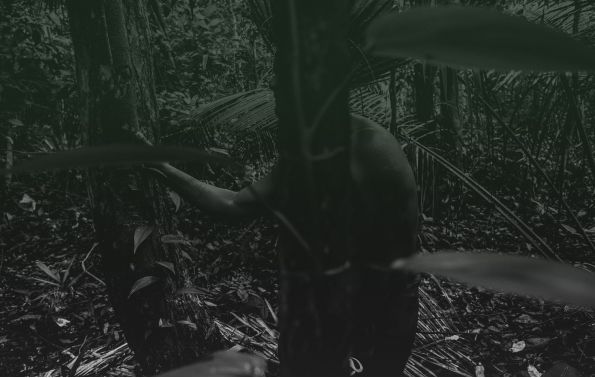About the Forest Guardians
Our crime prevention strategies and protection model was born during a scientific green criminology project in Brazil (2010-2016), funded by the Dutch NWO-WOTRO Science for Global Development Program. It was set up in collaboration with Brazilian universities and NGOs to identify and reduce social and environmental harm, including crime. The development strategy focused on access to justice and improving the rule of law.
In 2014, the first traditional communities that live near deforestation hotspots were equipped with waterproof GPS cameras, solar chargers and power bank. This allowed them to take pictures of illegal forest activities. In 2016, a twelve- member surveillance team from the Territory collected GPS-evidence of illegal activities within their territory which led to the removal of all illegal extractive industries.. This model can be replicated in other areas, especially in Indigenous and other protected areas with GPS borders.
The Forest Forces crime prevention strategies and model was born during a scientific green criminology project in Brazil (2010-2016), funded by the Dutch NWO-WOTRO Science for Global Development Program. It was set up in collaboration with Brazilian universities and NGOs to identify and reduce social and environmental harm, including crime. The development strategy focused on access to justice and improving the rule of law.

In 2014, the first traditional communities that live near deforestation hotspots were equipped with waterproof GPS cameras, solar chargers and power bank. This allowed them to take pictures of illegal forest activities. In 2016, a twelve- member surveillance team from the Territory collected GPS-evidence of illegal activities within their territory which led to the removal of all illegal extractive industries.. This model can be replicated in other areas, especially in Indigenous and other protected areas with GPS borders.
“In Brazil’s Maró Indigenous Territory, an Indigenous surveillance team collected GPS-evidence of illegal logging activities. When GPS-referenced pictures of illegal forest activities were presented to the Environmental Inspection Agency (IBAMA), a helicopter was sent to the location of the illegal activities the same day. Eight logging concessions were cancelled and timber companies were expelled from Indigenous territory as a result of the recorded evidence. The pilot project showed that local forest protection, even in remote areas without electricity or phone networks, can be carried out by supportive communities with access to trusted law enforcement actors.”
Outtake from 2021 UN module on Forest & Fauna
Timeline
2010-2016
NWO Research Grant awarded for development of access to justice model
2014
Utrecht University provide grant to create pilot program in the Maró Indigenous Territory
2016
As a result, 8 illegal logging concessions removed from Maró
2018
Munduruku Plan Alto Forest Guardians formed
2020
New headquarters funded and built for Indigenous Council of the Tapajos & Arapiuns
2021
Project peer-reviewed in the UN module on Forest & Fauna.
2022/23
Munduruku Takuara & Braganca Forest Guardians formed
2023
Treesistance platform launched following merger of Sinchi and Forest Forces.
OUR METHO-DOLOGY
The access for justice model was created by Dr. Tim Boekhout van Solinge, the Head of Forest Crime Prevention for the Treesistance. Tim is a criminologist specialised in forest and wildlife crime, illegal markets, and rule of law. He is a UN consultant and a research fellow at the Erasmus University Rotterdam and UFOPA University in Brazil. He has been active in the Brazilian Amazon since 2003.
STEp 1
Demarcating lands / Land Rights
Dependent on the situation / land rights status of the community, they may first need to demarcate and make the necessary land right claims through the courts. This can be a long process, however the good news is when a land claim is processed in the court, it automatically freezes the land which makes it illegal for any extractive industry to continue cutting down the forest. In most cases the claim should be accepted (the Brazilian constitution upholds Indigenous peoples rights).
This first step is essential to prove the illegality of deforestation from individuals or corporations extracting resources.
Step 2
Formation of Indigenous Forest Guardians
Each group of Forest Guardians consists of many members. Both male and female and ranging from the chief to teachers to students. They are provided training by Chief Dadá and his team (Indigenous peer to peer training) in using the technical equipment, de-escalation / safe confrontational techniques and safety. The amount of people here is vital as they need to outnumber those encroaching illegally. One person will take pictures with the GPS camera to take evidence of illegal activities, the location (gps provides exact coordinators for federal police) whilst the other members are spread out and documenting the exchange with mobile cameras for security.
The emphasis here is protection through prevention. This is the best deterrent and method to stop deforestation.
Step 3
Access to Justice – Relationship Development with public prosecutors and federal police.
Perhaps the most important but often overlooked part is action / implementation. Showing illegality, monitoring deforestation and even building evidence doesn’t mean anything if the evidence is not acted upon. And this requires the backing and support of strong institutions.
Our Strategies have been developed with public prosecutors, federal police and legal collectives on the ground over the last decade and ensure that when illegal activity is documented, that the necessary action will be taken. This may involve federal police for removal and arrests to the appropriate legal actions to remove permits to holding larger corporations accountable.
Accountable is essential in ensuring not just to stop current activities but to highlight that these acts will no go unpunished.
